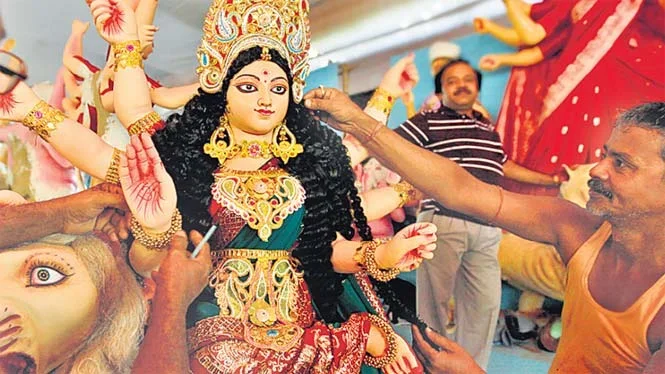prasad1
Active member
Perched atop a wooden platform, as the skilled hands of a bleary eyed Gobindo Nath draws the eyes of the 10-feet tall idol inside a darkened tent with a flickering bulb, the face of the goddess comes alive.
“This thin orange ring drawn inside the pupil is what gives the goddesses’ face the aura,” Nath tells a mesmerised employee standing below, clearly trying to learn tricks of the trade from the master himself. Thirty-nine-year old Nath, who lives in south Delhi’s Govindpuri, is one of the many artisans who make idols of Goddess Durga and her four children for the four-day long Durga Puja in the capital. For nearly three months a year, the tent erected inside the Shiv Mandir complex of Chittaranjan Park is home for Nath and score of other artisans who work for him. From about 15 in the 1950s to nearly 600 now, the number of Durga Puja pandals or marquees in Delhi NCR has spiralled. There are many artists who come to Delhi, particularly from Krishnanagar in West Bengal, for the months preceding the Puja. Then there are those like Nath, who have grown up here.
“I don’t remember when my father first came here to make idols but he stayed on. I have grown up playing with clay and making idols comes naturally to us,” says Nath. None of these artisans have any formal training in sculpting, it’s an art passed from generation to generation in a closely knit community. “We have learnt by watching our elders and if you study the human body closely, the musculature and bone structure, you get an idea of anatomy and proportions,” says Bhabesh Pal, 50, applying faux hair on the idols he is creating at the New Delhi Kali Bari. Wearing a soiled lungi and vest, Krishnanagar’s Pal feels at home at the temple premises, a home away from home. “I have been coming to Delhi for 10 years and will now move to Patna where I have order to make idols for Kali Puja,” he says. Despite the trek every year, Pal says the compensation is not adequate for the sheer amount of hard work they put in. The idols sell from anything between Rs. 35,000 to Rs. 1 lakh, depending on the size and intricacy of the work and costs of material have gone up too. But then, this is the only way they know how to make a living.
“It’s a vanishing art. Not because there is no demand, which is only increasing every year but because the younger generation wants a more comfortable living and this is too much hard work for them,” says Biswajit Pal, 51, another artisan.
“They prefer jobs that might not pay much but at least they get to spend some time with their families,” says Pal. Nath’s son studies in a ‘good’ school and he is not sure if he will follow in the footsteps of his forefathers. “It is for him to decide because the work is hard. Even my three brothers have moved on to other jobs.”
The work starts from June-August, when hay is put on a skeletal wooden frame, which is then covered with clay. From the clay to the paint and the idol’s clothes, hair and jewellery, nothing is from Delhi. “The clay comes from Jhajjar, Haryana because Delhi’s soil is not suited for this work. Everything else comes from Kolkata,” says Subir Pal (33), whose idols go to puja pandals in south Delhi, Rohini and Dwarka.
Subir’s father, Sambhu Pal, first came to Delhi in 1959 and became so popular for his idols that he did not have to go back. “Not only Durga Puja, number of other religious celebrations such as Ganesh Chaturthi has gone up. Number of Ganesh idols I make now is more than that of Durga idols,” he says. Their idols captivate the faithful for four days in pandals spread across Delhi NCR and the appreciation they get is the biggest remuneration, Subir says.
“It is tough when the puja organisers come to take the idols that you have worked on for months and shielded from the sun and rains. It is like giving away your mother,” he said.
He has never gone to see the idol’s immersion, ever.
“It is just too painful,” he says.
http://www.hindustantimes.com/india...rga-makers-need-prayers/article1-1270462.aspx

